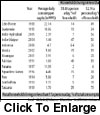The poor, to paraphrase Hemingway?s well-known quip about the rich, are just like you and me, except they have less money. How much less? The 1990 World Development Report from the World Bank defines the extremely poor as an individual who lives on $1 or less a day (at the 1985 purchasing power parity exchange rate). This is close to poverty lines used by many countries (for example, the all India rural poverty line used by the Indian Planning Commission was Rs 328 per person per month, or $32 in PPP dollars in 1999-2000) and has become something of a standard measure.
The poor (as opposed to the extreme poor) are defined to be those who live on less than $2 per person per day. To put all this in perspective, the poverty line in the US works out to be something like $13 a day. How does someone live on $1 per person per day? Or for that matter, how does one live on $2 per person per day? What do they spend their money on? How do they earn their living? What kind of infrastructure do they have access to?
In a recent study, Abhijit Banerjee and Esther Duflo of MIT look at household level survey data from 13 countries, including India (listed in table 1), and describe the patterns of consumption and income generation of the extremely poor, as well as their access to markets and public goods.* This is based on the Living Standard Measurement Surveys (LSMS) of the World Bank, the Family Life Surveys by the Rand Corporation, and in the case of India, surveys carried out in the Udaipur district of Rajasthan, and in the slum areas of Hyderabad by the authors along with their collaborators.
 While the surveys are not exhaustive or representative by any stretch, it is still a novel attempt to use household level data across countries to get a glimpse into the economic lives of the poor that remain hidden behind dry aggregate statistics such as what percentage of the population lives below the poverty line. What jumps out of the table is that there is considerable variation in living standards both within and across these countries: the poor are not a monolithic block. For example, within each country there is a fair bit of variation in terms of the relative size of the poor versus the extreme poor.
While the surveys are not exhaustive or representative by any stretch, it is still a novel attempt to use household level data across countries to get a glimpse into the economic lives of the poor that remain hidden behind dry aggregate statistics such as what percentage of the population lives below the poverty line. What jumps out of the table is that there is considerable variation in living standards both within and across these countries: the poor are not a monolithic block. For example, within each country there is a fair bit of variation in terms of the relative size of the poor versus the extreme poor.
Let us begin with the expenditure patterns of the extreme poor. As one would expect, food would be a major item of expenditure and given their resources and nutritional needs, they would be putting in as much they can on essential food items. Yet, interestingly, as table 2 shows, while food is indeed a major item of expenditure (56-78%), the extreme poor spend non-trivial sums on alcohol and tobacco. For example, expenditure on alcohol and tobacco exceeds that on education for a majority of these countries. This suggests that the extreme poor do have some margin of choice and choose not to exercise it in the form of buying more food. This is consistent with findings from research on nutrition in developing countries that suggest that a 1% increase on overall expenditure translates into about 66% increase in the total food expenditure. Given the presence of significant extent of malnutrition, as measured by the Body Mass Index (BMI) for example, it seems that, as the American writer James Baldwin put it darkly, it is extremely expensive to be poor.
If the poor do not live by bread alone, as seems to be the case, another intriguing finding from some of these surveys is that their self-reported levels of happiness are not particularly low even compared to developed countries. Yet, they report greater incidence of being under stress, and the prime causes for that are health problems and lack of food. In this respect, the poor in developing countries are more similar, than those in developed countries. Perhaps it is not that intriguing, after all. Casual empiricism suggests that if someone is asked, ?How are you?? or ?How is life?? the answer is more likely to be ?good? or ?OK? unless one probes deeper.
A striking fact that this study reveals about how the poor earn their living across these different countries is that they are ?entrepreneurs? in the following sense: they raise capital, carry out the investment, and are full residual claimants of the earnings. For example, they buy some fruits or vegetables at the wholesalers and sell them on the street. A large fraction of the rural poor operate a farm and many rural households operate a non-agricultural business. However, the enterprises are extremely small scale. For example, those who own land own tiny amounts of it, and most of it is not irrigated. Non-agricultural businesses tend to be too small scale to be efficient and staffed largely by family members. This clearly reflects lack of employment opportunities as well as lack of access to financial markets. An important policy question is whether to subsidise or encourage this form of ?petty? entrepreneurship (e.g., through microfinance) or whether to expand formal sector employment opportunities.
Access to infrastructure (for example, roads, electricity, water and sanitation) is a key element of quality of life. While poverty is measured in terms of private consumption, this is too narrow a view. Two groups of people with similar private consumption will have very different qualities of life if there are significant differences in their access to safe drinking water or medical care. From the evidence presented by this study (table 3), it appears that there is enormous inter-country variation. For example, in Tanzania electricity is available to only 1.1% households in the sample, whereas in Mexico to 99%. What is also clear is that there is variation within each country in terms of access to different types of infrastructure. In Indonesia, 96.9% households in the sample have access to electricity, and yet only 30.5% have access to toilets/latrines. This poses a challenge to economists to come up with better measures of poverty that put weight on deprivation in these dimensions. This also should give a moment of pause to those who have full faith on trickle-down economics: economic growth will not automatically take care of these problems.
This last point is reinforced by the evidence on the poor?s access to markets. In theory, access to markets can help the poor climb their way out of poverty. However, a feature that is common across these surveys is that very few poor households get a loan from a formal source. Even in urban areas where physical proximity of banks is not an issue, very few poor households receive loans from commercial banks. Most loans they do receive are from informal sources (relatives, shopkeepers, moneylenders) and the average interest rates are extremely high (almost 4% per month in the Udaipur survey). A related issue is the absence of good ways of holding savings, however small these might be. Very few poor households have savings accounts. Saving at home is subject to all sorts of problems, such as negative real rates of return, theft, and temptation to spend.
Economists have proposed many theories of persistence of poverty. A lot of these are variations on the theme of a vicious cycle. The poor are malnourished, which makes them less productive, earn less, and this keeps them malnourished. The poor save less because they discount the future more heavily (or have greater temptations to spend money on alcohol and tobacco) and that is why they stay poor. The poor have little to offer in the way of collateral, and as a result lenders are wary of lending to them, as a result they cannot expand their small businesses or acquire skills or afford education for their children. A simple way to classify them would be under the heads of market failure (e.g., the credit market story mentioned above), and behavioural problems (e.g., self-control, heavy discounting of the future).
This might seem too dry and academic, but poverty is the result of complex processes, and one cannot hope to blast it away by some magic bullet without understanding these processes. For example, there are some policies that can be helpful in addressing both market failure and behavioural problems of the poor. Reducing the costs of financial intermediation, for example, by innovative financial products (e.g., microfinance) that enable the poor to save and borrow more easily is an obvious candidate. Another policy that fits the bill is conditional cash transfers to poor families in exchange for regular school attendance by children (along with health clinic visits, and nutritional support) such as the well known Progressa programme in Mexico (now called Oportunidades). Designing and evaluating such programmes, to see what works where, is the central focus of current research in development economics.
*?The Economic Lives of the Poor,? Journal of Economic Perspectives, 2007, Vol. 21 (1), pp. 141-167
?The author is professor of economics at the London School of Economics
















